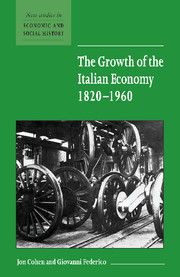Book contents
- Frontmatter
- Contents
- List of figures
- List of tables
- Acknowledgements
- 1 Introduction
- 2 Measuring change in the long run: the data
- 3 The big picture: models of growth and structural change
- 4 Modernization versus tradition: new views and old on agriculture
- 5 Against all odds? The growth of industry and services
- 6 Macroeconomic policy, institutions, and the balance of payments
- 7 An economic miracle? Italy in the Golden Age, 1945–1960
- 8 Conclusion
- Bibliography
- Index
- New Studies in Economic and Social History
- Previously published as Studies in Economic and Social History
- Economic History Society
1 - Introduction
Published online by Cambridge University Press: 05 June 2012
- Frontmatter
- Contents
- List of figures
- List of tables
- Acknowledgements
- 1 Introduction
- 2 Measuring change in the long run: the data
- 3 The big picture: models of growth and structural change
- 4 Modernization versus tradition: new views and old on agriculture
- 5 Against all odds? The growth of industry and services
- 6 Macroeconomic policy, institutions, and the balance of payments
- 7 An economic miracle? Italy in the Golden Age, 1945–1960
- 8 Conclusion
- Bibliography
- Index
- New Studies in Economic and Social History
- Previously published as Studies in Economic and Social History
- Economic History Society
Summary
1.1 Italy ranks today as one of the seven largest industrial countries in the world. Its people are among the world's richest whether one uses as a measure per capita income or the more broadly based Human Development Index (United Nations Development Program 1990). These observations alone would suggest that Italy's rise to economic prominence merits attention. But the country's success is all the more arresting because it was so unexpected. The city-states and principalities of the Italian peninsula were economic leaders in Europe for much of the period between the twelfth and the seventeenth centuries but their prosperity waned as the locus of economic activity and economic power shifted from the Mediterranean to the Atlantic. At the time of unification in 1861, much of the country was backward, poor and agrarian. Per capita income was roughly 50 per cent of that in Britain and about 60 per cent of that in France. While some Italians retained business skills and commercial know-how acquired during the late medieval and early modern economic expansion, very few, even among the country's most ardent champions, would have believed that, in a relatively short period of time, Italy would emerge as an industrial powerhouse. This process of growth and structural change has generated a huge and evolving literature, loaded with controversies and, often enough, compelling insights. The purpose of this monograph is to provide a concise, up-to-date account of this literature, to highlight new insights into old problems, and to signal areas desperately in need of more research.
- Type
- Chapter
- Information
- The Growth of the Italian Economy, 1820–1960 , pp. 1 - 5Publisher: Cambridge University PressPrint publication year: 2001
- 3
- Cited by

